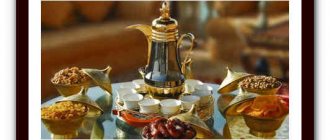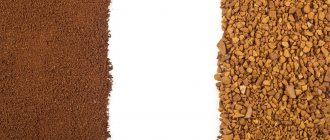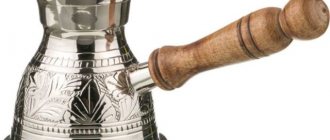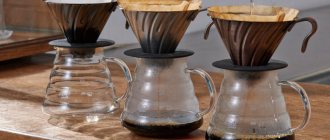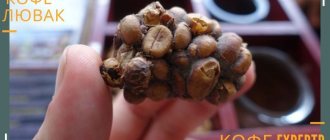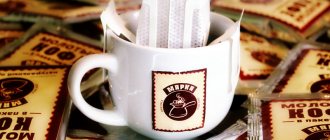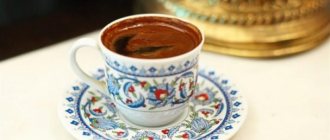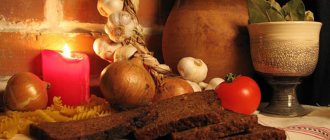Perhaps Turkish, cezve, Turkish or Oriental coffee is the most familiar method of preparation for all residents of the post-Soviet space. There were no Chemex or Siphons in our houses, but there was almost certainly a Turk. Unfortunately, they are not always suitable for making coffee. We recommend using a copper Turk; a real Turk should be copper on the outside and silver plated on the inside. Copper is an excellent conductor of heat, but upon contact with an acidic coffee environment, it begins to release dangerous carcinogens, so a protective coating is required inside the Turk.
Our parents and grandmothers knew how to cook coffee in a Turk on a gas stove. We have learned from our own experience that you can’t prepare a delicious drink this way. So, we are sharing a recipe on how to brew delicious coffee in a Turkish coffee pot.
Enjoy your coffee!
Oriental coffee needs to sit for a few minutes so that you drink the coffee and not eat it. Cezve is a huge field for experimentation - try heating a tiny amount of your favorite spices in a Turk before cooking, then add coffee and cook according to the instructions. Very popular recipes are: coffee with cinnamon, with pepper, with milk, and you can also add jams, syrups, honey and noble alcohol. Experiment with different types of coffee and find your favorite. Well, you can read how to brew coffee without a Turk in our other articles.
What is the difference between a Turk and a cezve?
Many coffee lovers wonder whether cezve and Turk are different or not. It should be noted that the formulation of the question is somewhat incorrect. But let's figure it out gradually. After all, this question interests many connoisseurs of a natural drink brewed with their own hands.
We suggest you first delve a little deeper into history.
What was the first coffee utensil?
Despite the fact that the history of such a product as coffee began more than a thousand years ago, it began to be poured with hot water 8-9 centuries ago. Of course, to prepare the first drinks, utensils were needed. At first, pots and pans were used for these purposes, but then the traveling Bedouins began to use a special jug called ibrik for these purposes. Ethnographers and archaeologists are inclined to believe that this is one of the most ancient types of dishes.
What is ibrik?
The name of the dish came from two words (experts are inclined to believe that they belonged to the Persian language) - water and pour. It is believed that ibrik is the first utensil for coffee, which for a long time remained the only one.
Ibrik is a small traveling jug. Typically its capacity was approximately 100 ml. But archaeologists managed to find stationary ibriks. Their volume was 100 liters. Of course, such giant jugs were not used for brewing coffee, but for storing water and wine.
The design feature of the ibrik was its thin and long spout, through which it was very convenient to pour hot water. The ibrik also had round sides that were shifted to the bottom of the product. They provided the ancient jug with stability and capacity. Despite many advantages, after several centuries the Bedouin camp jugs were replaced by another type of tableware - the dallah.
Dalla
Previously, coffee was mainly considered a drink of nomads and Bedouins. Then, with his penetration into Arabia, the picture changed dramatically. Now the drink has penetrated into noble, luxurious houses, thanks to the increased status of the product.
By the way, will you be in Saudi Arabia thinking about what souvenir to get for a coffee lover? Buy a dalla, a truly unique product.
Dalla is a fairly tall jug with a short spout. Since coffee became firmly established in the lives of noble families in Arabia, dalls looked accordingly. Often the jugs were embossed or had some unusual ornaments.
The main feature of such a jug was the spout. But one cannot fail to note the material. Dallu was made of metal. At one time, ibrik jugs were made of clay. And this was explained by the poverty of their owners.
This is interesting: the key difference between dallah and ibrik was the purpose of the utensils. The most ancient jug was also used for other liquids. But the dalla was intended exclusively for making coffee. By the way, dalla first appeared about 500 years ago.
Are jazz and Turkish the same thing or not?
To answer this question, we again have to delve into history.
What is a cezve
Cezve is a traditional utensil for making coffee, which has been widespread in Turkey and the Middle East since ancient times. This product is made of copper and has a long handle.
Interesting: it is believed that the word jezwa comes from the Arabic jadhwa, which means “burning coals.”
Despite the fact that dalls have long remained popular among those who like to treat themselves to a coffee drink, they are not at all suitable for preparing small portions of coffee. It was the cezve that replaced them. But this did not happen immediately.
At first, enterprising people of the East began to use small ladles as an alternative. But they did not take root, since the foam “ran away” when rising. Therefore, the guys had to improve the shape of the utensils intended for preparing their favorite drink. It was during the experiments that the cezve, familiar to many in the East, appeared.
What is Turka
Turka is a native Russian word. It turns out that Turkish merchants visiting Rus' on business matters were well aware that coffee was not a common drink on our territory. That is why traders brought with them the raw materials themselves, plus traditional oriental utensils for preparing their favorite drink. That’s why our people called the cezve “Turkish” - based on the nationality of the people who used these ladles to brew coffee.
And even when coffee entered the lives of the inhabitants of Rus', the original Turkic name “cezve” did not take root. Therefore, utensils intended for preparing a coffee drink remained Turkish.
So is there a difference?
As you can see, from our short linguistic excursion only one conclusion suggests itself. Turka and cezve are the same thing. There is absolutely no practical or functional difference between them. And each name is the national name of the same piece of utensils.
A turk or cezve is a small, thick-walled vessel characterized by a conical shape and a thick bottom. Also, such dishes have a long handle and a narrowed neck, thanks to which the coffee foam gradually rises and does not immediately run away (as was the case with ladles).
It is noteworthy that some countries have their own names for Turks (cezves). For example, serjep, fainjan, raka. But you need to understand that these are different names for the same type of cookware intended for making coffee.
Some interesting facts about the Turk (aka cezve)
There are many fascinating and instructive stories associated with this type of cookware, which is intended for preparing coffee drinks:
- Previously, in the countries of the Middle East, the level of a person’s well-being could be determined by the appearance of the cezve. After all, in rich houses, coffee was brewed in silver containers. Less prosperous sections of the population used copper products. And the poor brewed coffee in clay pots.
- For some reason, it is believed that the Turka was “invented” in Turkey. But it came to this country along with the product itself. The Turks were engaged in distributing and popularizing cezve around the world, as well as their own recipes for preparing this amazing and invigorating drink.
- The narrow neck of the Turk is designed to allow the rising coffee foam to act as a kind of stopper. This allows the aroma and taste of the drink to not evaporate, completely filling your cup.
Please note: modern containers with a wide neck cannot be called a Turk (cezve). At their core, they are banal buckets.
- After the person who invented the cezve first introduced it into the domain of the ruler, who ordered the invention of utensils for making coffee, as a reward he received the right to a monopoly trade in the miracle product. Thanks to this, the inventive master was able to earn a fortune by thinking of making conical-shaped dishes.
- There are classic parameters for the cezve. It turns out that the ratio of the diameters of the bottom and neck should be 2 to 1. In this case, the bottom can be even wider. This will only be beneficial.
- Craftsmen tried to combine all coffee traditions in one container. It is known that such a product had round sides (like the ancient ibrik), a narrow top (like the cezve that is popular today), and also a lid, which was like a dalla.
There are absolutely no differences between Turkish and cezve. Therefore, you can safely call the coffee utensils as you like.
What is the difference between a Turk and a cezve?
0 Number of votes: 60 3
5
1
60
Was the information helpful? Rate and leave a comment? Better yet, share!
Comments
We will be glad if you share your opinion or add to a note or article.
How to make Turkish coffee
Recipe for making Turkish coffee in a cezve step by step:
- Pour freshly ground grains into a container.
- Pour the water. It is advisable to have 10–12 g of powder per serving
- Add a spoonful of sugar.
- Place on the stove and wait for it to boil.
- As soon as the foam begins to rise, remove the cezve and set it aside for a minute, allowing it to settle thicker.
- Then put it on the fire again to boil again. Repeat this three times.
For taste, you can add spices - in the east they are preheated over a fire along with powder to release the essential oils. Next add milk or cream.
How did the Geyser Turk appear?
A geyser coffee pot differs from a regular coffee pot in that the brewing process is hidden in the body. This invention was invented at the beginning of the 19th century. Since then, the design of the device has changed, but the principle of operation remains the same: water, boiling inside, forms steam, which pushes the liquid onto the coffee tablet, and then flows into the upper container in the form of a finished drink.
At the moment, there are similar devices that run on electricity and turn off on their own - in a word, they save time.
The main question is what is better to brew coffee in, a Turkish coffee maker or a geyser coffee maker, and if there are any differences in taste. The experience of coffee lovers says the following: it doesn’t matter which device you buy, you need to buy high-quality beans for it. It is grains, not ground powder of unknown origin. Then the drink will be good both in a geyser and in a coffee machine.
Which Turk is better?
Aluminum Turk
Aluminum is a material with lower thermal conductivity than copper. However, aluminum is much cheaper. That is why it is considered more practical
: even if such a Turk bends, you don’t feel sorry for her; and it doesn’t cost anything to correct the product (that’s why the aluminum Turk is such a camping option).
What to do with the statement that aluminum cookware is harmful to health?
Indeed: the acidic environment of some products reacts with aluminum, “absorbing” a certain amount of it
. However, coffee brewed in an aluminum pot, to put it mildly, has nothing to do with an acidic environment.
And in general, let's dispel the myth about the dangers of aluminum cookware: it has been proven that even the most aggressive acidic environment (for example, a tomato in combination with lemon and vinegar
) removes such an amount of aluminum from dishes that is only 10 percent higher than the average daily dose of consumption of this metal.
Keep in mind!
The shape of aluminum turks, most often made by stamping, often differs from the classic-shaped
. Because of this, the aroma of coffee brewed in such a Turk is partially lost.
Aesthetically, the aluminum Turk also does not attract much attention. And yet, a cezve made from such material has a right to life, since the coffee prepared in it has quite decent taste
for the average person. In addition, such a Turk is so inexpensive that it can be changed at least once a week.
Where does the drink taste better?
How best to brew and which coffee tastes better - in a Turk or a coffee maker - depends only on the type of coffee beans and preparation technology. Many people do this: they buy a geyser and test it. Next, they buy Turka and test it on the same type of beans. If you are not satisfied with the quality, they take a coffee machine.
Both good devices - a geyser and a traditional cezve - will cost no more than one hundred dollars. A geyser with cappuccino alone will handle that amount. Warning:
- testing requires high-quality grains, otherwise the result will be unsatisfactory;
- They need to be chopped just before cooking.
An electric geyser is more expensive, but the quality of the drink is the same, so there is no point in overpaying.
Coffee
It is a very common belief that dark roasted coffee performs well in cezve. In fact, experts recommend using light roast coffee, roasted under a filter (alternative), that is, group D. Properly prepared coffee will open up perfectly, you will catch all the floral, berry, fruit and other flavor notes that your grain is rich in. Turkish coffee also has special roasting requirements, but I will talk about this another time when I have more information.
What about dark roast?
I tried brewing dark roast Cuba Serano. The coffee turned out to have a pronounced cocoa bitterness (very similar to roasted cocoa beans or chocolate containing 99% cocoa). The bitterness appeared even brighter than in espresso. Sugar makes a wonderful flavor if you like to add it to your coffee.
Dalla - another vessel for brewing coffee
Dalla – used for making coffee in several areas of Syria, Yemen and Saudi Arabia. It is a small saucepan with a curved spout and a long handle. Its shape resembles a closed cezve, as it has a wider bottom and a slightly narrowed upper part. The design is very successful, because if you leave the dalla on the fire, coffee will begin to flow through a long spout, where you can easily place a cup.
Dallah comes from an Arabic jug called irbik. Traditionally it was used to store water and coffee was first brewed in it. If you look at it, you can see a shape similar to the cezve and dallah, namely a wide bottom and a narrow top, only the spout is on the lower part of the vessel. So they moved it up, and it turned out to be a dalla. Today, irbik is used in Arab countries for its intended purpose - no one brews water and coffee in it anymore.
